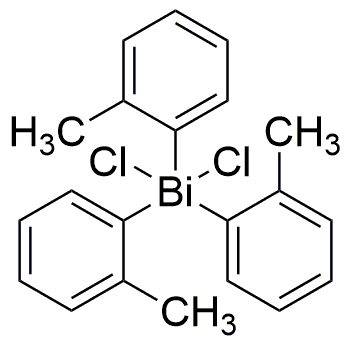Tri-o-tolylbismuth dichloride is widely utilized in research focused on:
- Organometallic Chemistry: This compound serves as a precursor for synthesizing various organometallic compounds, which are essential in catalysis and materials science.
- Pharmaceutical Development: It is explored for its potential applications in drug formulation, particularly in developing new therapeutic agents with improved efficacy.
- Environmental Chemistry: Used in studies to understand the behavior of heavy metals in ecosystems, helping to develop strategies for pollution remediation.
- Electronics Industry: It plays a role in the production of advanced materials for electronic devices, enhancing performance and reliability.
- Research on Anticancer Agents: Investigated for its biological activity, contributing to the development of novel compounds for cancer treatment.
General Information
Properties
Safety and Regulations
Applications
Tri-o-tolylbismuth dichloride is widely utilized in research focused on:
- Organometallic Chemistry: This compound serves as a precursor for synthesizing various organometallic compounds, which are essential in catalysis and materials science.
- Pharmaceutical Development: It is explored for its potential applications in drug formulation, particularly in developing new therapeutic agents with improved efficacy.
- Environmental Chemistry: Used in studies to understand the behavior of heavy metals in ecosystems, helping to develop strategies for pollution remediation.
- Electronics Industry: It plays a role in the production of advanced materials for electronic devices, enhancing performance and reliability.
- Research on Anticancer Agents: Investigated for its biological activity, contributing to the development of novel compounds for cancer treatment.
Documents
Safety Data Sheets (SDS)
The SDS provides comprehensive safety information on handling, storage, and disposal of the product.
Product Specification (PS)
The PS provides a comprehensive breakdown of the product’s properties, including chemical composition, physical state, purity, and storage requirements. It also details acceptable quality ranges and the product's intended applications.
Certificates of Analysis (COA)
Search for Certificates of Analysis (COA) by entering the products Lot Number. Lot and Batch Numbers can be found on a product’s label following the words ‘Lot’ or ‘Batch’.
Numéro de catalogue
Numéro de lot/série
Certificates Of Origin (COO)
This COO confirms the country where the product was manufactured, and also details the materials and components used in it and whether it is derived from natural, synthetic, or other specific sources. This certificate may be required for customs, trade, and regulatory compliance.
Numéro de catalogue
Numéro de lot/série
Safety Data Sheets (SDS)
The SDS provides comprehensive safety information on handling, storage, and disposal of the product.
DownloadProduct Specification (PS)
The PS provides a comprehensive breakdown of the product’s properties, including chemical composition, physical state, purity, and storage requirements. It also details acceptable quality ranges and the product's intended applications.
DownloadCertificates of Analysis (COA)
Search for Certificates of Analysis (COA) by entering the products Lot Number. Lot and Batch Numbers can be found on a product’s label following the words ‘Lot’ or ‘Batch’.
Numéro de catalogue
Numéro de lot/série
Certificates Of Origin (COO)
This COO confirms the country where the product was manufactured, and also details the materials and components used in it and whether it is derived from natural, synthetic, or other specific sources. This certificate may be required for customs, trade, and regulatory compliance.


